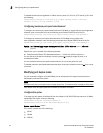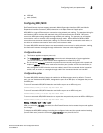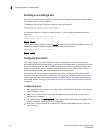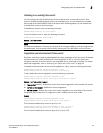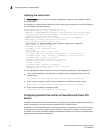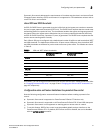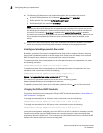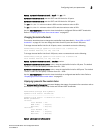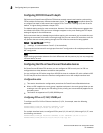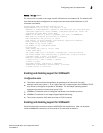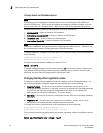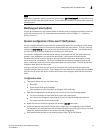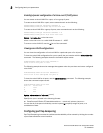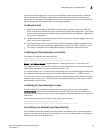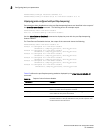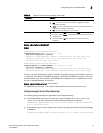
44 PowerConnect B-Series FCX Configuration Guide
53-1002266-01
Configuring basic port parameters
2
Configuring PHY FIFO Rx and Tx depth
PHY devices on PowerConnect B-Series FCX devices contain transmit and receive synchronizing
FIFOs to adjust for frequency differences between clocks. The phy-fifo-depth command allows you
to configure the depth of the transmit and receive FIFOs. There are 4 settings (0-3) with 0 as the
default. A higher setting indicates a deeper FIFO.
The default setting works for most connections. However, if the clock differences are greater than
the default will handle, CRCs and errors will begin to appear on the ports. Raising the FIFO depth
setting will adjust for clock differences.
Dell recommends that you disable the port before applying this command, and re-enable the port.
Applying the command while traffic is flowing through the port can cause CRC and other errors for
any packets that are actually passing through the PHY while the command is being applied.
Syntax: [no] phy-fifo-depth <setting>
• <setting> is a value between 0 and 3. (0 is the default.)
This command can be issued for a single port from the IF config mode or for multiple ports from the
MIF config mode.
NOTE
Higher settings give better tolerance for clock differences with the partner phy, but may marginally
increase latency as well.
Configuring the IPG on PowerConnect Stackable devices
On PowerConnect B-Series FCX devices, you can configure an IPG for each port. An IPG is a
configurable time delay between successive data packets.
You can configure an IPG with a range from 48-120 bit times in multiples of 8, with a default of 96.
The IPG may be set from either the interface configuration level or the multiple interface level.
Configuration notes
• This section describes the configuration procedures for PowerConnect Stackable devices.
• When an IPG is applied to a trunk group, it applies to all ports in the trunk group. When you are
creating a new trunk group, the IPG setting on the primary port is automatically applied to the
secondary ports.
• This feature is supported on 10/100/1000M ports.
Configuring IPG on a 10/100/1000M port
To configure an IPG of 112 on Ethernet interface 0/1/21, for example, enter the following
command.
PowerConnect(config)# interface ethernet 0/1/21
PowerConnect(config-if-e1000-0/1/21)# ipg 112
For multiple interface levels, to configure IPG for ports 0/1/11 and 0/1/14 through 0/1/17, enter
the following commands.
PowerConnect(config)# interface ethernet 0/1/11 ethernet 0/1/14 to 0/1/17
PowerConnect(config-mif-0/1/11,0/1/14-0/1/17)# ipg 104



